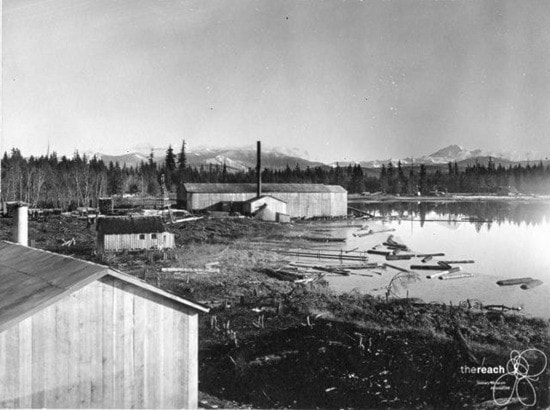Faces, Places and Traces by Mark Rushton
Just past the turn of the 20th Century, what we know today as Abbotsford, with its vibrant agricultural industry, was a truly different place.
Our community in those days was an industrial engine. Clayburn Company, located on and adjacent to Sumas Mountain, was producing bricks for shipping around the world, and in the heart of what is now the city, Abbotsford Lumber Company was one of the largest employers in the province.
Today’s Mill Lake, with its walking paths, boardwalks and lawns, may be Abbotsford’s crown jewel, yet for some 30 years following the turn of the century, it was a smoke-filled industrial center with its own ‘town’ surrounded by dense forests. Apparently, the original name was Abbotsford Lake, but that appellation was soon discarded due to the fact its main purpose was to serve as the log-sorting pond for Trethewey’s lumber mill.
The first mill on the lake was started by professor and anthropologist Charles Hill-Tout, its purpose to supplement his income by manufacturing railway ties. In 1903, the Trethewey family, headed by Joseph Ogle Trethewey, purchased the mill and turned it and Mill Lake into an industrial hub.
The company had its own railway system throughout the area, with narrow-gauge locomotives hauling logs from the surrounding area to the lake, crossing it at the west end near what is now Centennial Pool and dumping them into the water. Even today, there are remnants of the trestle pilings among the lily pads.
According to MSA Museum, there was also a rail line “that ran along the present day Mill Lake Road to Robertson Avenue and then to Hazel Street to connect with the CPR in Abbotsford to ship out the finished products across Canada.
“Timbers produced at the mill were even used in the construction of the Welland Canal in Ontario.
“The mill site was known locally as ‘Milltown’ due to the sprawl of the mill buildings, company housing and general store. The company built several boarding houses, one each for the white, Sikh and Japanese single men, as well as cottages for families of each ethnic group.”
“The mill machinery operated on steam. As the mill ran twenty-four hours a day for the most part, dumped all its tailings and sawdust into the lake and was permanently veiled in a haze of smoke, no doubt Milltown was a singularly unpleasant place to live. Luckily for the rest of the community, Milltown was well outside of town at that time.”
‘Town,’ of course, was ‘Abbotsford’ – developed less than a mile east of Mill Lake and, according to MSA Museum, located where it was due to a forest fire providing a natural clearing in the forest.
At its peak in the 1920s, the mill was producing 20 million board feet of lumber and an equal number of shingles annually.
However, by the 1930s, not only had most of the timber been logged off but the Great Depression hit.
By 1934, the mill was closed, assets dismantled and sold.
Since there was no cleanup other than what could be salvaged for sale, the site was a mess.
Recognizing the danger of derelict buildings, says MSA Museum, the Abbotsford Lions Club and the District of Matsqui took on the task of cleaning up the former mill site and reclaimed Mill Lake as a community recreation area.
And popular it became, for picnickers, swimmers and boaters.
I remember in the late ’60s/early ’70s not only water skiing on the lake but, on the occasional late night, skinny-dipping in Mill Lake.
The ski boats have long been banned – not so sure about the skinny-dipping!
markrushton@abbynews.com
